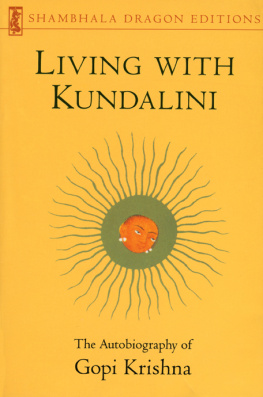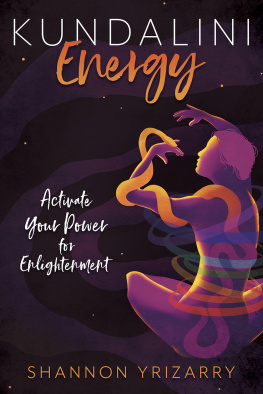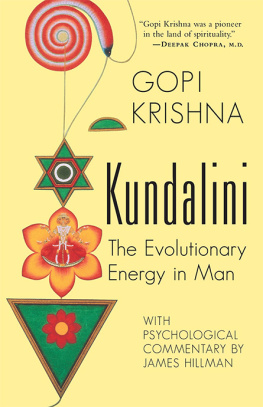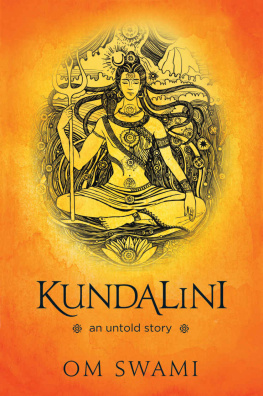Sign up to receive weekly Tibetan Dharma teachings and special offers from Shambhala Publications.

Or visit us online to sign up at shambhala.com/edharmaquotes.

Photo: Charles D. Robison
LIVING WITH
KUNDALINI

The Autobiography of Gopi Krishna
EDITED BY LESLIE SHEPARD


SHAMBHALA
Boulder
2017
Shambhala Publications, Inc.
4720 Walnut Street
Boulder, Colorado 80301
www.shambhala.com
1993 by The Kundalini Research Foundation, Ltd.
All rights reserved. No part of this book may be reproduced in any form or by any means, electronic or mechanical, including photocopying, recording, or by any information storage and retrieval system, without permission in writing from the publisher.
Library of Congress Cataloging-in-Publication Data
Gopi Krishna, 1903
Living with Kundalini: the autobiography of Gopi Krishna / edited by Leslie Shepard.
p. cm.(Shambhala dragon editions)
eISBN 9780834824713
ISBN 9780877739470
1. Gopi, Krishna, 1903 . 2. HindusIndiaBiography. 3. Kualin. I. Shepard, Leslie. II. Title.
BL1175.G62A3 1993
294.5092dc20 | 93-21829 |
[B] | CIP |
THIS IS ONE of the most important books ever published.
This may seem like a sweeping claim when one considers the vast riches of literaturethe revealed scriptures of various religions, the plays of Shakespeare, or the works of great novelists and religious geniuses. After all, this is the story of the life and philosophy of a very ordinary man, a minor Indian civil servant from Kashmir who failed in his college examinations. Yet this very ordinary man stumbled on the greatest secret of life, the key to that infinite ocean of consciousness from which all great geniuses and mystics draw inspiration. Throughout history, this secret has been known under many different namesnirvana, samadhi, satori, the Muslim concept of hal, mystic union, spiritual marriage, cosmic consciousness, God-realization.
It is one of the best-kept secrets, for the different paths to this supreme revelation have been obscured by the poetic metaphors and allegories of different faiths and philosophies, and many attempts to explain the ecstatic interpenetration of finite and infinite existence have failed, so that the experience itself has become legendary. Over centuries of material progress and scientific development, even the validity of the experience has been questioned or dismissed as a psychoneurotic phenomenon, half-believed in by the faiths of different religions whose very inception stemmed from the God-realization of inspired saints and sages. But that was all long ago and far away.
So for thousands of years, millions upon millions of men and women have struggled through life, richer or poorer, in sickness or health, without access to this great secret. They have known the joys and sorrows of life and sexual union, the rearing of children, suffered good and bad fortune, only to find at the end of their lives that everything in the material worldfame, fortune, wealth, possessions, and relationshipsare all ephemeral and pass away at death. Even the consolations of religions have often dwindled to well-meaning platitudes or mere ritual and dogma, unable to cross the gap between life and death.
In modern times, under the banner of the New Age, there has been a new manifest hunger for something more meaningful in life than ambition, money, power or possessions. Hundreds of cults and revisionist religions have sprung up, claiming to offer transcendental meaning. Some, such as the Fundamentalist revivals in the Christian and Muslim worlds, have proved dangerous to world politics and peace, stirring up simplistic fanaticisms and racist empire building. Some of the New Age gurus have proven to be charlatans, enjoying the ego-satisfaction and adulation of thousands of devotees, misfit messiahs parroting the inspired teachings of the past but without any transcendental experience of their own. Other gurus have been dangerous messengers of death and destruction for their pathetically deluded followers, as with the cults of the Reverend Jim Jones, Charles Manson, or various neo-Satanist groups.
Another tragic blind alley was the Psychedelic Revolution, which promised cosmic consciousness in a capsule, but seduced millions of men, women and children into becoming dropouts, manipulated by an international cartel of Mafia-style crime barons and their empire of pushers.
Much of the New Age has been marked by trivial and banal novelties, with old and new gimmicks like astrology, tarot cards, the IChing, crystals, and soothsayers, all enveloped in a stupefying heavy fog of incense and soporific music.
But the New Age and its mass media gurus at least revived the ancient Indian concept of kundalini, a latent energy in the universe and in the human body, the dynamic behind sexual expression and also, through meditation, the way to higher consciousness, with side effects of psychic phenomena. Although most of the time, the gurus were simply rehashing ancient teachings of the past as their own, without personal experience, the concept of kundalini is a true one. Only if you want to know about it, it is useless to follow teachers without real experience, who are only concerned with building their own reputations and cults. You will need to listen to someone with total experience of kundalini in both its negative and positive aspects, who knows its place in the evolution of the human race. This teacher is Pandit Gopi Krishna.
It is one of the ironies of fate that this supreme secret should have been revealed once more in modern times to an ordinary man, a gentle, modest individual without a cult, concerned only with sharing his transcendental knowledge with the rest of the world.
He founded no movement, demanded no money, refused to become the center of adoring crowds, and merely lived humbly in relative poverty, writing his inspired books about Kundalini and its place in human evolution.
The title Pandit is a traditional honorific bestowed on one who is recognized as an authority on a subject. Pandit Gopi Krishna is outstanding as an authority on Kundalini. There are few modern authorities on the subject who speak, as he does, from such detailed personal experience.
The beauty of the present work is that it describes in detail the stages of the awakening of the awesome power of kundalini in one individual, the years of struggle to balance and harmonize this force, the psychic gifts which it brought, and the validation of the subject in ancient treatises from India, China and other countries, and the mystery traditions of both East and West.
This autobiography opens with a prologue describing firsthand the incredible experience of the fabulous awakening of kundalini. The Pandit goes on to describe frankly the progress of this dynamic energy against the background of his daily life, the trials and agonies of taming the force, and harmonizing it, the paranormal side effects of prophecy and inspired verse, the obligation to live a socially productive life and share insights with the rest of humanity.
Next page















